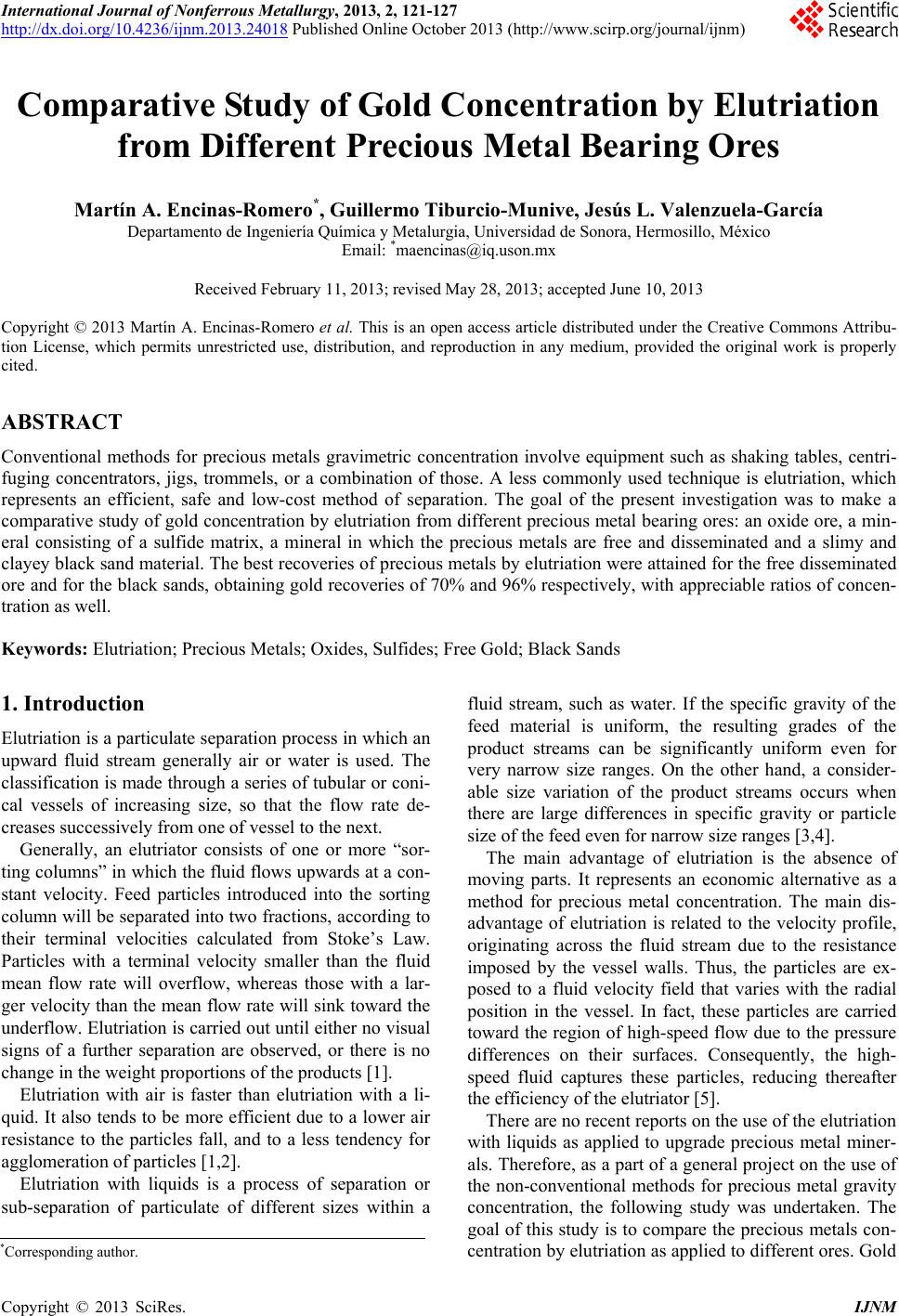
International Journal of Nonferrous Metallurgy, 2013, 2, 121-127
http://dx.doi.org/10.4236/ijnm.2013.24018 Published Online October 2013 (http://www.scirp.org/journal/ijnm)
Comparative Study of Gold Concentration by Elutriation
from Different Precious Metal Bearing Ores
Martín A. Encinas-Romero*, Guillermo Tiburcio-Munive, Jesús L. Valenzuela-García
Departamento de Ingeniería Química y Metalurgia, Universidad de Sonora, Hermosillo, México
Email: *maencinas@iq.uson.mx
Received February 11, 2013; revised May 28, 2013; accepted June 10, 2013
Copyright © 2013 Martín A. Encinas-Romero et al. This is an open access article distributed under the Creative Commons Attribu-
tion License, which permits unrestricted use, distribution, and reproduction in any medium, provided the original work is properly
cited.
ABSTRACT
Conventional methods for precious metals gravimetric concentration involve equipment such as shaking tables, centri-
fuging concentrators, jigs, trommels, or a combination of those. A less commonly used technique is elutriation, which
represents an efficient, safe and low-cost method of separation. The goal of the present investigation was to make a
comparative study of gold concentration by elutriation from different precious metal bearing ores: an oxide ore, a min-
eral consisting of a sulfide matrix, a mineral in which the precious metals are free and disseminated and a slimy and
clayey black sand material. The best recoveries of precious metals by elutriation were attained for the free disseminated
ore and for the black sands, obtaining gold recoveries of 70% and 96% respectively, with appreciable ratios of concen-
tration as well.
Keywords: Elutriation; Precious Metals; Oxides, Sulfides; Free Gold; Black Sands
1. Introduction
Elutriation is a particulate separation process in which an
upward fluid stream generally air or water is used. The
classification is made through a series of tubular or coni-
cal vessels of increasing size, so that the flow rate de-
creases successively from one of vessel to the next.
Generally, an elutriator consists of one or more “sor-
ting columns” in which the fluid flows upwards at a con-
stant velocity. Feed particles introduced into the sorting
column will be separated into two fractions, according to
their terminal velocities calculated from Stoke’s Law.
Particles with a terminal velocity smaller than the fluid
mean flow rate will overflow, whereas those with a lar-
ger velocity than the mean flow rate will sink toward the
underflow. Elutriation is carried out until either no visual
signs of a further separation are observed, or there is no
change in the weight proportions of the products [1].
Elutriation with air is faster than elutriation with a li-
quid. It also tends to be more efficient due to a lower air
resistance to the particles fall, and to a less tendency for
agglomeration of particles [1,2].
Elutriation with liquids is a process of separation or
sub-separation of particulate of different sizes within a
fluid stream, such as water. If the specific gravity of the
feed material is uniform, the resulting grades of the
product streams can be significantly uniform even for
very narrow size ranges. On the other hand, a consider-
able size variation of the product streams occurs when
there are large differences in specific gravity or particle
size of the feed even for narrow size ranges [3,4].
The main advantage of elutriation is the absence of
moving parts. It represents an economic alternative as a
method for precious metal concentration. The main dis-
advantage of elutriation is related to the velocity profile,
originating across the fluid stream due to the resistance
imposed by the vessel walls. Thus, the particles are ex-
posed to a fluid velocity field that varies with the radial
position in the vessel. In fact, these particles are carried
toward the region of high-speed flow due to the pressure
differences on their surfaces. Consequently, the high-
speed fluid captures these particles, reducing thereafter
the efficiency of the elutriator [5].
There are no recent reports on the use of the elutriation
with liquids as applied to upgrade precious metal miner-
als. Therefore, as a part of a general project on the use of
the non-conventional methods for precious metal gravity
concentration, the following study was undertaken. The
goal of this study is to compare the precious metals con-
centration by elutriation as applied to different ores. Gold
*Corresponding author.
C
opyright © 2013 SciRes. IJNM